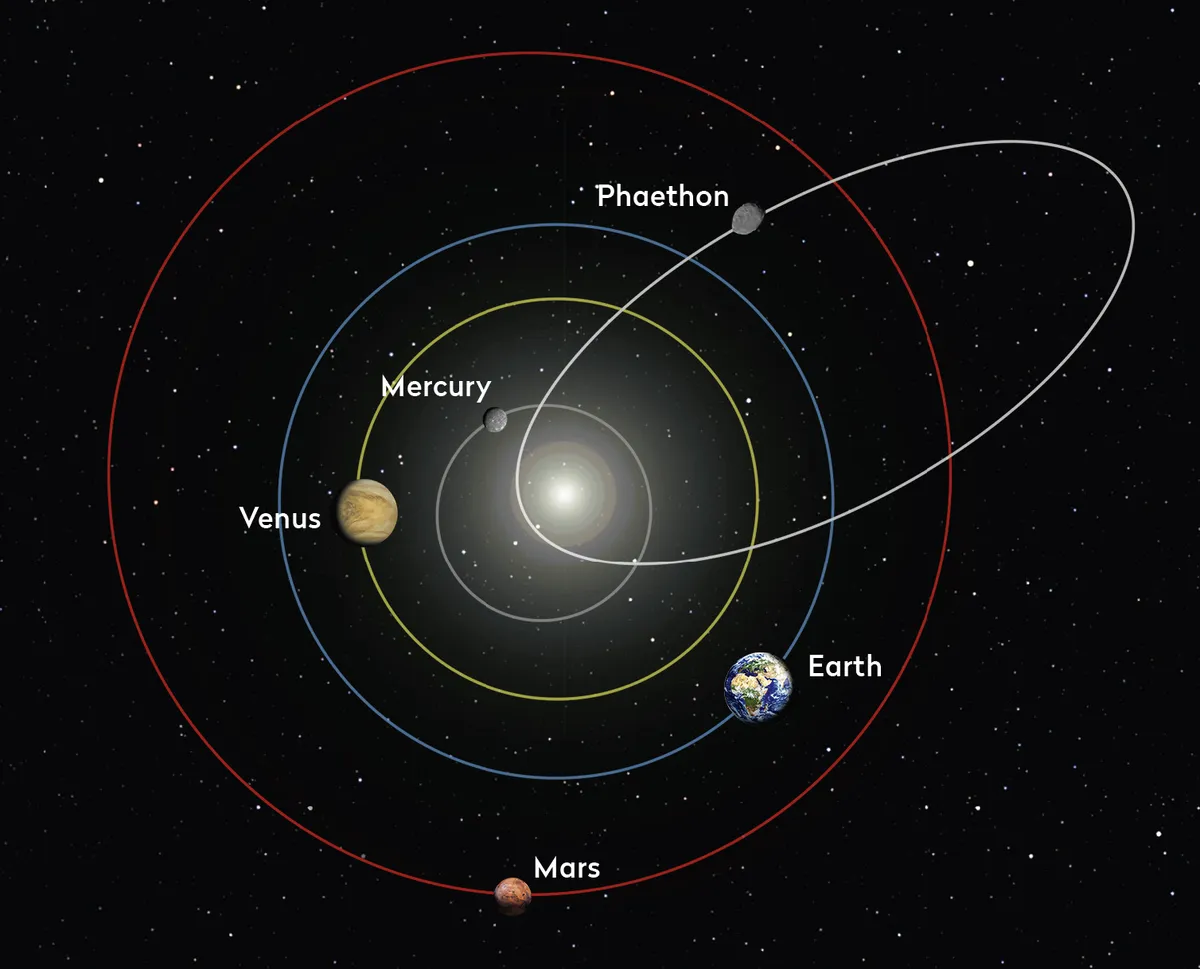You may have seen the Geminid meteor shower before, but did you know that it's caused be asteroid 3200 Phaethon?
Every December, Earth sails through a stream of dusty debris scattered throughout the Solar System. These tiny grains vaporise in our atmosphere creating a shower of meteors known as the ‘Geminids’.
Under the scrutiny of some of the world’s most powerful telescopes, clues are emerging about the origin of the Geminid meteor shower as the enigmatic wanderer implicated in the birth of this celestial show – an object known as ‘3200 Phaethon’ – is uncovered in ever more detail.

The puzzle of Asteroid 3200 Phaethon
“The puzzle started a long time ago with the Geminids meteor stream,” says Professor David Jewitt – a planetary scientist and expert on Phaethon – from the University of California, Los Angeles.
“Whereas most meteor streams consist of particles released from comets, the Geminids had no known parent, despite people having looked for one.”
In the early 1980s the Infrared Astronomical Satellite (IRAS) spotted a new asteroid, 3200 Phaethon.
Its path around the Sun appeared to align with the clouds of interplanetary material responsible for the Geminid meteor shower.
The IRAS discovery brought with it a slew of fresh questions, however.
“The new puzzle, and the one we are still working on, is that Phaethon is an asteroid not a comet. How can an asteroid produce the Geminid meteor stream?” says Jewitt.
Early studies tried to catch Phaethon behaving like a comet, ejecting dusty material into space. Yet the asteroid seemed inactive.
“Then, one day my wife, Jing Li, suggested that we should try to look at Phaethon near perihelion,” says Jewitt.

Perihelion is the point in an object’s orbit where it’s nearest the Sun, and for Phaethon that is a blisteringly close 21 million km from our star.
“Most telescopes can’t look there, but Jing is a solar astronomer and she knew all about the telescopes on the STEREO spacecraft that are designed to point into the Sun.”
When STEREO’s images were analysed they showed the little asteroid increasing in brightness as it faced the onslaught of the Sun’s heat.
This was not the behaviour of an icy object – akin to a comet – warming as it approached our star.
Phaethon was being baked at more than 700°C. At those temperatures any ice would be long gone.
Instead, astronomers argued the surface of Phaethon was emitting grains into space as it dried and cracked in the searing heat.

In this unusual process lay another mystery.
Researchers were able to work out the quantity of dust being shed by Phaethon during its close swoop into the Sun’s inner realm.
It was nowhere near what’s required to explain the amount of dust in the Geminid stream.
The astronomers used the Hubble Space Telescope to observe Phaethon as it was passing by Earth in 2017.
“We wondered if Phaethon could be active away from perihelion as well, but just launching big particles that would be hard to see in most telescopes,” recalls Jewitt.
Hubble didn’t see anything. That in itself said something important about the way Phaethon may have produced the Geminid meteoroid stream.
“What it means is that the mass loss from Phaethon cannot be in steady state,” explains Jewitt.
“We need about 700kg/s to supply the Geminids but the STEREO observations gives us only 3kg/s. We need more than one hundred times as much, but [Hubble] shows that this is not happening.
"So we conclude that Asteroid 3200 Phaethon didn’t produce the Geminids in a steady way, but perhaps impulsively as a result of some disruptive event in the last few thousand years.”
A ‘disruptive event’ might be a collision with another object or an explosion on Phaethon caused by buried ice sublimating.
However, Jewitt suggests these scenarios are unlikely due to the emptiness of space and the anticipated high temperature of the asteroid.
“Other people, and I’m one of them, note that the rotation period of Phaethon (3.6 hours) is very close to the period at which gravity would be unable to hold the body together,” says Jewitt. “So maybe it shed some material because it was spinning too fast.”
That theory has its pitfalls too, though.
“The problem is that we need this event to have occurred recently and the implication is that we are just lucky to be on-scene at the right time to see the consequences,” explains Jewitt.
“Reasonable people argue that appealing to this kind of luck is a step too far. I tend to agree with that.”

Cracking the Geminid code
While it remains unclear what exactly went on to scatter the Geminid meteorid stream into space, researchers continue to examine what Phaethon is made of and where it might have originated – information that could illuminate the enduring enigma of the Geminids.
For Teddy Kareta, a graduate student at the University of Arizona, trying to understand Phaethon’s make-up has been a key aspect of his PhD research.
He has used telescopes in Arizona and Hawaii to capture spectra of Phaethon – essentially a series of chemical fingerprints that are hidden in the light from the asteroid.
Those fingerprints need to be decoded, and the way Kareta and his fellow researchers intend to do that is by baking meteorites to examine how their spectra match up to the signatures in Phaethon’s glow.
"When we started trying to interpret our observations of Phaethon, we realised that most previous experiments that heated meteorites to high temperatures, to compare to telescopic measurements, simply didn’t get hot enough to be a great comparison to Phaethon," says Kareta.
"The options were to give up and say that we need better data, or build a vacuum heating chamber in the basement of our building."
The researchers did the latter and, at the time of writing, they are now preparing the apparatus for its first experimental run.
"The general idea is that we grind up a meteorite, put it inside the heating chamber, pump all the air out, and then heat it up and cool it down over and over to replicate what being in an eccentric near-Sun orbit might be like," explains Kareta.
"We’re planning on heating up organic and water rich meteorites as the most likely analogues for Phaethon," he adds.
Research like Kareta’s provides context for the understanding of Phaethon’s origin.
Some scientists think the asteroid could be a piece hewn off the much larger asteroid Pallas. Kareta isn’t so sure.
While Pallas’s and Phaethon’s spectra – the chemical signature of their surface in their light – are alike, the amounts of sunlight they reflect (a characteristic known as an object’s ‘albedo’) are not.
“When Phaethon moved into its current orbit and started getting really hot, its surface properties were cooked and changed as a result,” explains Kareta.
“When you cook a meteorite in the lab, the spectra and albedo both change, so we think it’s hard to explain Phaethon as just being a cooked fragment of Pallas.”
While Kareta and his colleagues’ research works to build a picture of Phaethon’s composition, other teams have been collecting actual images of the asteroid to examine its shape and size.
As Phaethon was swinging by Earth in December 2017, astronomers using the Arecibo radio telescope in Puerto Rico were bouncing radio waves off the asteroid to create a radar image of it.

“We find that Phaethon is roughly spherical in shape and rather non-descript,” says Dr Patrick Taylor, from the Lunar and Planetary Institute in Texas, who led the team using Arecibo.
“From the variation in signal strength in the radar images, we can hypothesise that some of the features are a large crater at the low latitudes of Phaethon and possibly a large boulder,” he explains.
“We believe Phaethon has a shape very similar to asteroids Bennu and Ryugu, currently being visited by the OSIRIS-REx and Hayabusa2 spacecraft, but much, much larger.”
Following these radar glimpses, scientists should soon get even better pictures of Phaethon.
The Japanese space agency, JAXA, hopes to launch a mission – named DESTINY+ – to the asteroid in 2022.
It’ll be equipped with a range of imaging cameras and scientific instruments to examine Phaethon, and it could help answer some of the big questions that remain about this intriguing object.
For Teddy Kareta, the opportunity to finally see the asteroid’s surface up-close is a thrilling prospect.
“For decades, Phaethon has been emblematic of everything we don’t know about asteroids, comets, and everything in between,” he says.
“[It] is at the centre of one of the great mysteries of the inner Solar System, and I’m just stoked that we’re gonna go and take a look.”

How big is Asteroid 3200 Phaethon?
We put Asteroid 3200 Phaethon in context by comparing its size to some well-known objects, both terrestrial and celestial.
Phaethon: 6km (diameter)
Bennu, the asteroid investigated by NASA’s OSIRIS-REx sample-return mission: 500m (diameter)
The Shard, London's iconic building overlooking the River Thames: 309.6m (height)
The London Eye on London’s South Bank: 135m (height)
Comet 67P, the body visited by ESA’s Rosetta mission: 4.34km (longest side)
Ceres, the dwarf planet lurking in the main asteroid belt: 945km (diameter)
This article originally appeared in the December 2019 issue of BBC Sky at Night Magazine.
